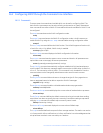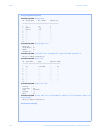
16–4 MULTILINK ML2400 ETHERNET COMMUNICATIONS SWITCH – INSTRUCTION MANUAL
SNMP CHAPTER 16: SNMP
16.2 Configuring SNMP through the Command Line Interface
16.2.1 Commands
There are several commands and variable which can be set for configuring SNMP. The
basic SNMP v1 parameters can be set by referring to the section on System Parameters.
Most commands here refer to SNMP v3 commands and how the variables for SNMP v3 can
be configured.
The
snmp command enters the SNMP configuration mode.
snmp
The
snmpv3 command enters the SNMP V3 configuration mode. It is still necessary to
enable SNMP V3 by using the
set snmp command after entering configuration mode.
snmpv3
The
set snmp command defines the SNMP version. The ML2400 supports all versions (v1,
v2 and v3) or only v1. By default, SNMP v1only is enabled.
set snmp type=<v1|all>
The
show snmp command displays the SNMP configuration information.
show snmp
The
setvar command sets the system name, contact and location. All parameters are
optional but a user must supply at least one parameter.
setvar [sysname|syscontact|syslocation]=<string>
The
quickcfg command automatically configures a default VACM (view-based access
control model). This allows any manager station to access the ML2400 either via SNMP v1,
v2c or v3. The community name is “public”. This command is only intended for first time
users and values can be changed by administrators who want more strict access.
quickcfg
The
engineid command allows the user to change the engine ID. Every agent has to
have an
engineID (name) to be able to respond to SNMPv3 messages.
engineid string=<string>
The
authtrap command enables or disables authentication traps generation.
authtrap <enable|disable>
The
show-authtrap command displays the current value of authentication trap status.
show-authtrap
The
deftrap command defines the default community string to be used when sending
traps. When user does not specify the trap community name when setting a trap station
using the
trap command, the default trap community name is used.
deftrap community=<string>
The
show-deftrap command displays the current value of default trap.
show-deftrap
The
trap command defines the trap and inform manager stations. The station can receive
v1, v2 traps and/or inform notifications. An inform notification is an acknowledgments that
a trap has been received. A user can add up to 5 stations.


















